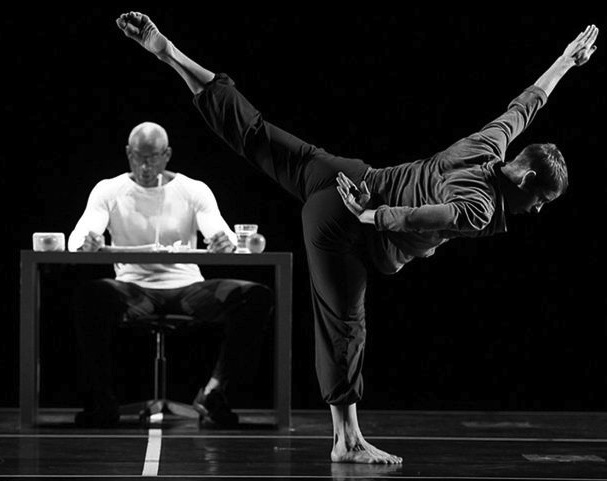Dance Review: A Memorable “Story/Time” From Bill T. Jones
As for pulling out themes from Bill T. Jones’ gathering of tales, well, the bedrock of human existence seems to be very much on his mind — life and death, landscape and memory.
Story/Time, presented by Bill T. Jones/ Arnie Zane Company at the Institute of Contemporary Art, February 21-23.
By Iris Fanger
A story-teller as much as a choreographer and performer, movement has never been the sole means for Bill T.Jones to express himself and his concerns. I remember back to his first appearance with his late partner, Arnie Zane (at Sanders Theatre, Harvard), in the early ’80s, before they established their company. The pair performed a series of duets which had Jones talking directly to the audience while they danced. Then as now, he was working out an understanding of our national identity as well as his status in the land of his birth as a gay, black man — his words were nervy, fearless, outspoken. That was before the AIDS epidemic claimed Zane’s life in 1988 and the dramatic change in attitudes about gays in American society.
His penchant for verbal discourse, paired with choreography which produced such memorable works as Last Supper at Uncle Tom’s Cabin and Still/Here among others, takes on new form in Story/Time, which was presented last weekend in three sold-out performances at the Institute of Contemporary Art. Inspired by John Cage’s 1958 Indeterminacy, a series of brief writings recited in chance order, and Merce Cunningham’s 1965 work How To Kick, Pass, Fall and Run, for which Cage read a group of the one-minute anecdotes, Jones has written a large number of 60-second narratives which he reads on stage during Story/Time. Jones intones the stories seated at center stage at a table: snatches of dancing, sound effects and, late in the evening, a cloud of theatrical fog that gradually wafts out over the audience embellish the experience. His splendid company of nine dancers present varied choreography with each change of subject.
The premise: a group of 70 stories is picked at random for each presentation. The time shows up on a digital clock at the rear of the stage, which disappears then reappears near the end. The dancers crouch at the side of the stage, ready for their cues to enter.
Among the qualities of Jones that I have most admired are his loyalty and his notion of history and how it relates to him. When he was a dancer, he was stunning on stage — tall, precise, and charismatic in the specific determination of his expansions into space. He is no less formidable as a narrator, who has organized the performance into a theatrical event that goes well beyond merely reading to the audience.
The stories are largely autobiographical, rummaging backward and forward in time: they deal with his early career and life with Zane, his current relationship with set designer Bjorn Amelan, now his life partner, his family, especially his mother, Estrella, his father, Gus, and sister Rhodessa, and the many people — famous and otherwise — whom he has met over the years. Otherwise, he waxes poetic and Biblical, reading the story of Noah in the Old Testament or beautifully describing images from the Northern Mesa of Arizona where he and Amelan have a home. The set pieces for Story/Time are sparse, a leather couch and a chair, carried on and off by the dancers plus a grouping of large, square, translucent screens, designed by Amelan, that are configured in different ways throughout the piece.
The show’s choreography, also arranged by Janet Wong, Associate Artistic Director of the troupe, does not connect specifically to the individual stories, except now and then. One example of movement that fits the verbal content finds the performers rolling right to left across the stage, with the fog machine belching smoke that drifts over them. At the end of the segment, the glass window of the back wall at the ICA performance space was revealed, with city and seascape lighted behind it. That visual expanse is always good for a wow of a finish.
As for pulling out themes from Jones’ gathering of tales, well, the bedrock of human existence seems to be very much on his mind — life and death, landscape and memory. I admire everything Jones has done because I admire him as a man, a thinker, an artist, and an entrepreneur, reveling in his administrative tasks at New York Live Arts, his change of pace from contemporary dance to Broadway, and his zest for the inevitable changes in a man’s life as he continues his creative journey. He has quite a story to tell.
An another Arts Fuse review (from Debra Cash) of Story/Time.
Iris Fanger is a theater and dance critic based in Boston. She has written reviews and feature articles for the Boston Herald, Boston Phoenix, Christian Science Monitor, New York Times, and Patriot Ledger as well as for Dance Magazine and Dancing Times (London).
Former director of the Harvard Summer Dance Center, 1977-1995, she has taught at Lesley Graduate School and Tufts University, as well as Harvard and M.I.T. She received the 2005 Dance Champion Award from the Boston Dance Alliance and in 2008, the Outstanding Career Achievement Award from the Graduate School of Arts and Sciences at Tufts. She lectures widely on dance and theater history.

